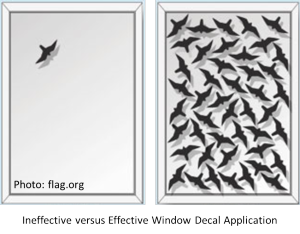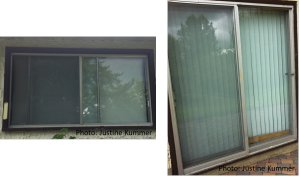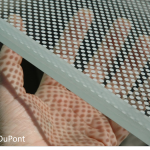How You Can Help!
Injured Birds
Please follow one of the following links if you find an injured bird at your home:
What should I do if I find an injured bird?
What do I do with an injured or orphaned bird?
Additionally, you can take the bird to your local wildlife rehabilitation facility.
Dead Birds
If you find a dead bird at your home please contact Corey Scobie, Assistant Curator of Ornithology and consider donating the bird to the Royal Alberta Museum for research
Preventing Collisions
Many factors influence bird window collisions. By understanding how various characteristics influence bird collisions, we may be able to decrease the number of window strikes. For the best chance at reducing collisions you should use several internal and external techniques. Several tactics joined together will have the greatest success at preventing both injuries and fatalities.
Below is a list of ways you can help reduce the number of window collisions at your home:
- Place bird attractants within 1 meter of windows. Birds are drawn to the attractant but due to the closeness of the window they are unable to build up enough momentum to sustain serious injury if they hit the glass upon departure (Klem et al. 2004). Placing feeders more than 10 meters from a window will also reduce risk. At this distance birds are more likely to recognize the reflected image as part of a house and are less likely to fly toward it for safety.
- Uniformly cover the window surface with decals and hanging strings of objects. Objects should uniformly cover the surface and be separated by 10 cm (4 in) or less in vertical columns or 5 cm (2 in) or less in horizontal rows. A new product based on this research are Acopian BirdSavers which can be placed on the outside of windows. Decals placed on windows and objects in front of windows create an interference pattern that reduces the mirror effect of reflective windows and makes transparent windows more visible (Klem 1990).

- Keep interior blinds and shutters closed. This helps minimize reflections and angled appropriately, these can still provide plenty of light and a modified view (Klem 2009).
- Move houseplants away from windows. Birds will not consider plants and flowers to be shelter or food when they are placed where they cannot be seen from outside (Klem 2009).
- Angle windows 20-40° downwards. Angled windows reflect the ground rather than the sky or vegetation and substantially reduce window strikes (Klem et al. 2004).
- Cover windows with netting. Fine mesh netting stretched tightly over an entire window causes birds to “bounce” away before crashing into window glass and will not obstruct the view (Klem 2009).
- Use ceramic frit glass. Windows with ceramic frit glass should have 0.32 cm (0.13 in) diameter translucent appearing dots separated 0.32 cm (0.13 in) apart. Fritted glass has granules fused onto it to create a frost-like pattern that reduces its reflectivity and transparency when looking at a window from the outside (Klem 2009).
- Use one-way films that consist of chosen patterns and colour shades. These films provide a minimally obstructed view from inside while rendering a window opaque or translucent when viewed from the outside (Klem 2009).
- Create a pattern on your windows using ABC BirdTape. This tape has been tested and approved by bird experts at American Bird Conservancy to alert birds to the presence of glass while allowing you to see out your windows from the inside. Cut the tape to a desired length and form one of the patterns below on your windows.
- Use UV window decals or glass with a UV pattern built in. Recent research indicates that birds are alerted to the presence of glass when they detect a UV pattern applied to a window. Window Alert window decals have adapted this UV concept. The reflected UV light is thought to be seen as a bright, iridescent glow to a bird’s eye, but invisible to humans. Additionally, Arnold Glas has developed a bird protection glass called, “Ornilux” that, they state, prevents up to 71% of bird-window collisions. Ornilux glass adopts the UV concept by applying UV patterns onto the glass which are highly visible to birds and almost imperceptible to humans (flap.org).






